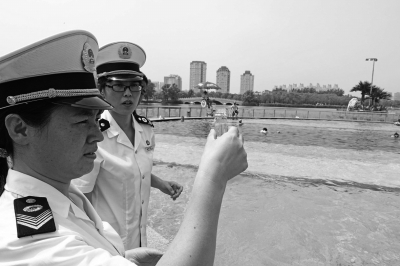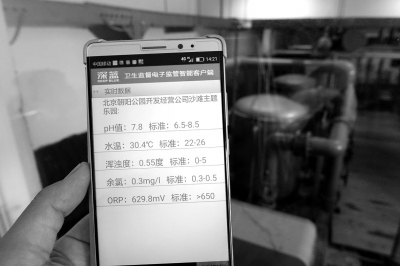Investigation of Beijing Swimming Venues: The water quality of swimming pools is generally low in residual chlorine and high in urea.


With the coming of summer and the rising temperature, the popularity of major swimming venues in Beijing is bursting. However, is the pool of clear water really as clean as it looks? Recently, the reporter followed the staff of the Municipal Health Supervision Office to test the water quality of several outdoor swimming pools, and found that the water quality of the swimming pools tested had problems such as low residual chlorine and high urea.
According to Liu Ying, deputy section chief of the Public Health Supervision Department of the Municipal Health Supervision Office, according to the national standards, the water quality inspection of swimming venues mainly targets at five health indicators (water temperature, residual chlorine, PH value, turbidity and ORP). Among them, if the concentration of residual chlorine is too low, it will not disinfect the pool water, and the bacteria and pathogenic microorganisms in the pool water may multiply too much, thus causing the spread of diseases; If it is too high, it may stimulate the human eye mucosa, skin mucosa and oral mucosa, especially for sensitive people such as children, women and the elderly. In addition, there is a common problem of high urea in swimming pools, which is also harmful to human body.
After the reporter’s visit and understanding, the water quality of swimming pools is not up to standard, which is mostly caused by operators cutting corners to save money.
site
The residual chlorine of newly added disinfectant is still lower than the national standard.
At 2 o’clock on the afternoon of July 6, the reporter followed the staff of the Municipal Health Supervision Office to the seaside paradise of Tuanjiehu Park in Beijing. The reporter saw at the scene that many people were swimming and playing in the pool.
Subsequently, the staff of the Municipal Health Supervision Office went to a swimming pool, took out water from the swimming pool and tested it with test paper for residual chlorine. After about 1 minute, the test data showed that the residual chlorine value was 0.1 mg/L. Subsequently, the staff went to another swimming pool and asked the tourists to take out a small bottle of water in the center of the swimming pool for testing. The test results showed that the residual chlorine was 0.2 mg/L.
The reporter learned that in order to maintain the hygiene of swimming pool water and kill pathogenic microorganisms in the pool water, swimming venues will add a certain dose of chlorine-containing disinfectant while circulating and filtering the pool water, thus producing free residual chlorine. The national standard of residual chlorine concentration in swimming pool water is 0.3-0.5 mg/L. However, in this inspection, the residual chlorine in swimming pool is lower than the national standard. A person in charge of the swimming pool admitted to the staff of the Municipal Health Supervision Office that the swimming pool had just added chlorine-containing disinfectant to the swimming pool for less than an hour.
Liu Ying introduced that if the concentration of residual chlorine is too low, it will not disinfect the pool water, and the bacteria and pathogenic microorganisms in the pool water may multiply too much, thus causing the spread of diseases; If it is too high, it may stimulate the human eye mucosa, skin mucosa and oral mucosa, especially for sensitive people such as children, women and the elderly. In addition, the high temperature and strong sunlight in summer will decompose residual chlorine, so the consumption of residual chlorine in summer will be particularly large. It will be very dangerous if the residual chlorine is not replenished enough or not.
In addition to the Binhai Paradise, the Municipal Health Supervision Office also tested the beach theme park of Chaoyang Park, and detected the residual chlorine at several points on the spot, and the residual chlorine data at one point was also slightly lower.
Excessive sources of urea in swimming pool are perspiration and urination.
According to the relevant national standards, the urea in swimming pool water should be less than or equal to 3.5 mg/L. However, according to the data of previous years, the problem of urea exceeding the standard in swimming pools is widespread.
Liu Ying said that when the urea content is too high, ammonia in urea will form chloramines with chlorine-containing disinfectants, which will make swimmers feel disgusted, irritate skin, cornea and corrode scalp.
Liu Ying said that many swimming pools now adopt overflow circulation filtration, and its principle is to collect the water overflowing from the swimming pool into the water tank, and then pump the water into the sand tank with a circulating pump for filtration and then put it back into the swimming pool. Although impurities such as hair will be filtered out, the bacterial content cannot be reduced, and urea must be replaced with new water to reduce the content. Urea can’t be removed through the filtration and circulation equipment. Every day, people keep swimming, sweating or urinating in it, and urea will get higher and higher, so the swimming pool management needs to replenish fresh water immediately.
"At present, we are also removing urea by other methods without changing water. It is through urea separation technology that the organic matter is decomposed. However, this technology is also expensive, and only a few swimming venues are in use. " Liu Ying said.
It is understood that there is urea in the swimming pool, on the one hand, people will keep sweating while swimming, on the other hand, someone will urinate in the swimming pool.
cause
In order to save money and disinfect, "cut corners"
The reporter learned that many swimming pools in Beijing adopt overflow circulation filtration. In order to save money, some swimming pools don’t even open or only open the circulation system at night. However, the water is not changed for a long time, and the circulation system is not turned on. In order to keep the water clear, some swimming pools repeatedly use polyaluminum chloride precipitant to adsorb suspended solids in water. The naked eye looks clear and transparent, but in fact, the water body is rich in aluminum ions, which will do harm to the human body, especially the eyes.
In addition, some swimming venues also have "cutting corners" in disinfection. According to some insiders, generally speaking, a 1000-cubic-meter swimming pool costs about 10,000 yuan a month for disinfectants, precipitants and other disinfection materials. The quality and price of various disinfectants in the market are uneven. In order to save money, some operators choose cheap disinfectants, and the disinfection effect is difficult to guarantee.
counter-measure
Real-time monitoring system can see the water quality at any time.
In order to cope with the upcoming swimming peak, at present, 100 swimming pools in the city started the activity of "Sweeping the water quality of swimming pools" last month. Citizens can scan this QR code through their mobile phones in obvious places in the swimming pool, and know the residual chlorine, turbidity, pH value and other values of the swimming pool at the first time before swimming. If substandard conditions are found, the public can complain about the problems found through the public health service hotline 12320.
The reporter learned that the Municipal Health Supervision Office has installed real-time monitoring systems in 100 swimming venues, and most of them are outdoor, crowded, school, community and undertaking some major international and domestic events, which accounts for about 80% of the total number of swimmers.
At present, the electronic supervision and command center of Beijing swimming venues has been completed, which monitors five main sanitary indicators (water temperature, residual chlorine, PH value, turbidity and ORP) of swimming venues in real time, and updates a set of data in 5 minutes to 7.5 minutes. Once the warning line is touched, the police will be called immediately, and the supervisor will immediately rush to the scene for treatment. In case of hot weather, the health supervision department will strengthen the supervision and inspection of outdoor swimming pools.
"In order to ensure the water quality, the municipal health supervision department will increase the inspection frequency of swimming pools, especially the problem swimming pools." Liu Ying said that the municipal health supervision office will focus on solving the problems of turbidity and excessive urea content in the pool water that citizens are concerned about, and health supervision institutions at all levels will urge swimming pool operators to strengthen their own management through training and guidance, and at the same time give administrative penalties for illegal acts according to law.
小贴士
游泳者如何判断和维护水质?
1.到现场一般需要先看下水质的现状,浑浊度现行的国标标准是5,真到5的话已经很浑浊了,没法看了。所以用肉眼看基本上很清澈可以见底,那肯定是在国家标准范围内。
2.站在泳池边闻闻有没有氯气的味道,最好是有淡淡的氯气的味道,不能太浓,也不能闻不到。太浓的话说明余氯超标,会对人体有伤害,闻不到说明余氯太少,达不到消毒效果。
3.像PH值或者浑浊度可能会在实时监测系统上看看数据,然后再结合现场感官现状做一个初步判定。
4.因为男士皮屑多,女士化妆品多,到水里后有机物溶解进去通过一般方法不容易去掉,必须通过强氧化剂分解掉。所以建议广大游泳爱好者养成泳前淋浴等习惯。
国家标准
水温:22-26
余氯:0.3mg/l-0.5mg/l
PH值6.5-8.5
浊度:0-5
ORP:>650
尿素<3.5mg/l
京华时报记者王海欣摄 京华时报记者马金凤